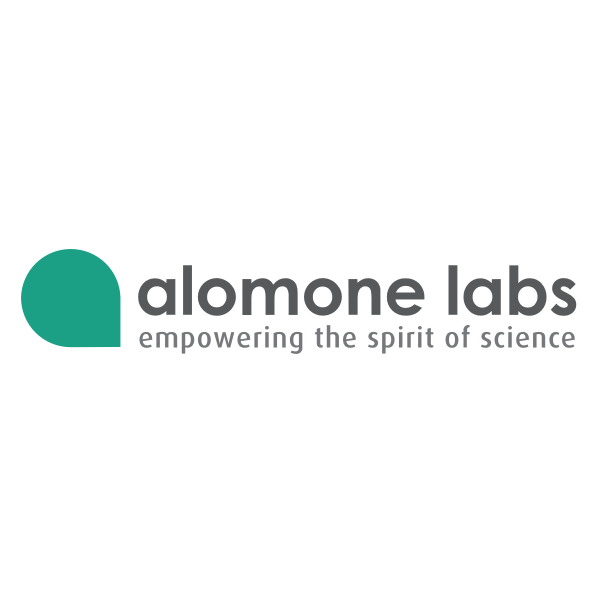

品牌: Alomone
 下载产品说明书
下载产品说明书 用小程序,查商品更便捷
用小程序,查商品更便捷



 收藏
收藏
 对比
对比 咨询
咨询纯度:
Affinity purified on immobilized antigen.
Affinity purified on immobilized antigen.
反应种属:
R
R
产品介绍
产品信息
纯化方式
Affinity purified on immobilized antigen.

宿主
Rabbit

免疫原
Peptide (C)KASGEVSKHLYKVWKK, corresponding to amino acid residues 402-417 of rat kainate receptor GluK1 (Accession P22756). Extracellular, N-terminus.

简单描述
A Rabbit Polyclonal Antibody to Kainate Receptor GluK1

商品描述
Alomone Labs is pleased to offer Anti-GRIK1 (GluK1) (extracellular) Antibody (#AGC-008), a highly specific antibody directed against the extracellular N-terminus domain of the rat kainate receptor GluK1. The antibody can be used in western blot and immunofluorescence applications.

同种型
Rabbit IgG.

纯度
Affinity purified on immobilized antigen.

形式
Lyophilized

组成成分
抗GRIK1抗体(抗谷氨酸受体离子型红藻氨酸1抗体),0.05%叠氮化钠溶液

基因
GRIK1

应用
实验应用
ICC, IF, IHC, LCI, WB

反应种属
R

预测反应种属
H, M

背景
别名
Glutamate receptor ionotropic kainate 1, Glutamate receptor 5, GluR5

背景
L-Glutamate, the major excitatory neurotransmitter in the central nervous system (CNS), operates through several receptors that are categorized as ionotropic (ligand-gated cation channels) or metabotropic (G-protein-coupled receptors).
The ligand-gated ion channel family consists of fifteen members that have been subdivided into three families based upon their pharmacological profile: the α-amino-3-hydroxy-5-methyl-4-isoxazolepropionic acid (AMPA)-preferring receptors, the N-methyl-D-aspartate (NMDA)-preferring receptors, and the kainate-preferring receptors.
The kainate receptor subfamily consists of five members that have been further subdivided into two classes based upon structural homology and functional characteristics. GluR5, GluR6, and GluR7receptor subunits share a high degree of homology and are able to form functional channels when expressed in heterologous systems. The KA-1 and KA-2 receptors are unable to form functional channels on their own, but when coexpressed with GluR5-7 receptor subunits, they form channels with high affinity for kainate.1,2
Like AMPA receptors, the functional unit of endogenous kainate receptors is believed to be a tetramer, which can be either homomeric or heteromeric. Kainate receptors GluR5 and GluR6 (but not GluR7, KA-1, or KA-2) can undergo RNA editing; as in the AMPA receptor GluR2, a glutamine (Q) residue in the channel pore is edited to encode arginine (R) in the mature protein. Substitution of Q with R modulates the properties of the channel, producing channels with reduced single channel conductance and lower permeability to Ca2+.1,2
GluR5 is highly expressed in dorsal root ganglion (DRG) neurons of the peripheral nervous system (PNS) as well as in several structures of the CNS including the amygdala, the hipoccampus, and Purkinje cells of the cerebellum.
GluR5 has been implicated in the modulation of synaptic transmission and synaptic plasticity in both the CNS and PNS, but the exact physiological function of GluR5 is not well understood. Nevertheless, an involvement in persistent pain and some types of learning has been proposed.
The ligand-gated ion channel family consists of fifteen members that have been subdivided into three families based upon their pharmacological profile: the α-amino-3-hydroxy-5-methyl-4-isoxazolepropionic acid (AMPA)-preferring receptors, the N-methyl-D-aspartate (NMDA)-preferring receptors, and the kainate-preferring receptors.
The kainate receptor subfamily consists of five members that have been further subdivided into two classes based upon structural homology and functional characteristics. GluR5, GluR6, and GluR7receptor subunits share a high degree of homology and are able to form functional channels when expressed in heterologous systems. The KA-1 and KA-2 receptors are unable to form functional channels on their own, but when coexpressed with GluR5-7 receptor subunits, they form channels with high affinity for kainate.1,2
Like AMPA receptors, the functional unit of endogenous kainate receptors is believed to be a tetramer, which can be either homomeric or heteromeric. Kainate receptors GluR5 and GluR6 (but not GluR7, KA-1, or KA-2) can undergo RNA editing; as in the AMPA receptor GluR2, a glutamine (Q) residue in the channel pore is edited to encode arginine (R) in the mature protein. Substitution of Q with R modulates the properties of the channel, producing channels with reduced single channel conductance and lower permeability to Ca2+.1,2
GluR5 is highly expressed in dorsal root ganglion (DRG) neurons of the peripheral nervous system (PNS) as well as in several structures of the CNS including the amygdala, the hipoccampus, and Purkinje cells of the cerebellum.
GluR5 has been implicated in the modulation of synaptic transmission and synaptic plasticity in both the CNS and PNS, but the exact physiological function of GluR5 is not well understood. Nevertheless, an involvement in persistent pain and some types of learning has been proposed.

制备和贮存
溶解方法
25 µl, 50 μl or 0.2 ml double distilled water (DDW), depending on the sample size.

保存方式
The antibody ships as a lyophilized powder at room temperature. Upon arrival, it should be stored at -20°C.
数据库链接
Entrez-Gene ID
29559

UniProt ID
P22756

研究资源识别码
AB_2039896.

声明 :本官网所有报价均为常温或者蓝冰运输价格,如有产品需要干冰运输,需另外加收干冰运输费。







 危险品化学品经营许可证(不带存储) 许可证编号:沪(杨)应急管危经许[2022]202944(QY)
危险品化学品经营许可证(不带存储) 许可证编号:沪(杨)应急管危经许[2022]202944(QY)  营业执照(三证合一)
营业执照(三证合一)